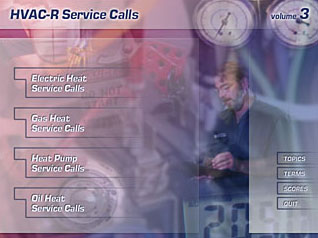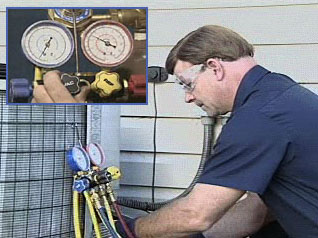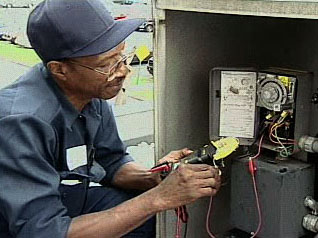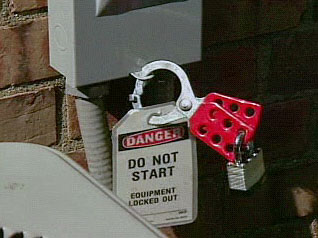HVAC Skills: HVAC-R Service Calls #3

- Product ID
- dlmrhvc3
- Training Time ?
- 112 to 224 minutes
- Language(s)
- English
- Video Format
- Standard Definition
- Required Plugins
- MasteryNet Player
- Lesson Interactions
- 6
- Quiz Questions
- 40



This training is the third in a series of three volumes. The series consists of 12 lessons intended to teach the basics of servicing HVAC-R equipment. The lessons move from general troubleshooting methods and procedures to working with specific types of equipment. Actual service calls are presented, giving the learner insight into authentic job situations. Customer service and safety are always stressed, with certain basic troubleshooting steps presented as universals.
The lessons are designed to show the student the steps needed to find the problem, not to detail the specific repair. The series provides an excellent visual introduction to the most common problems facing today’s HVAC-R technician.
![]() This course is in the Advantage™ format, to read about Advantage™ features click here.
This course is in the Advantage™ format, to read about Advantage™ features click here.

- Rich multimedia presentation with interactions and quiz
- Print certificate and wallet card
- You have 30 days to complete the course
Training for anyone interested in pursuing a career or furthering their career as an HVAC-R Technician.
- Electric Heat Service Calls
- Gas Heat Service Calls
- Heat Pump Service Calls
- Oil Heat Service Calls
-
Troubleshoot electric heat furnace problems.
- Explain which speeds the furnace blower is designed to run on during heating and cooling.
- Recall how many BTU's are generated by one watt of electrical energy
- Identify the control that shuts off the heating element if it gets too hot.
- Identify the safety device that shuts off the heating elements if the fan switch should fail.
- Explain how the heating elements are energized.
- Explain how the relays are energized.
- Explain how the blower is energized.
- Explain how the sequencers are energized.
- Recall how many CFM of air are required for heating and air conditio
-
Troubleshoot gas heat furnace problems.
- Recall that older gas furnaces used standing pilot systems.
- Explain how the heat anticipator works.
- Explain how the heating circuit can be energized.
- Explain how the temperature rise of the furnace is determined.
- Identify the formula to check for proper air flow.
- Recall how many times a gas furnace with an HIS system will try to ignition before locking out.
- Identify the first component to be energized on a furnace that has an HIS system.
- Explain how the combustion chamber is purged.
- Recall when the main gas valve is energized.
-
Troubleshoot heat pump problems.
- Identify the reversing valve.
- Recall where the discharge gas is sent during the heating mode.
- Recall where the discharge gas is sent during the cooling mode.
- Identify where the liquid refrigerant is metered during the heating mode.
- Identify where the liquid refrigerant is metered to during the cooling mode.
- Explain why heat pumps require a defrosting cycle.
- Explain how the refrigerant changes in the outdoor coil.
-
Troubleshoot oil heat furnace problems.
- Identify the control that proves combustion of oil has taken place.
- Recall the resistance value of a good cad cell.
- Recall that the primary control provides 24 volts across the T-T terminals.
- Describe a primary control that has interrupted ignition.
- Explain how the burner motor and ignition transformer are energized.
- Explain how the primary control works.
- Recall that the cad cell lead wires are wired to the F-F terminals of the primary control.
- Explain how the safety switch of the primary control works.
- Recall when the primary control safety switch will trip reset button.
© Mastery Technologies, Inc.

